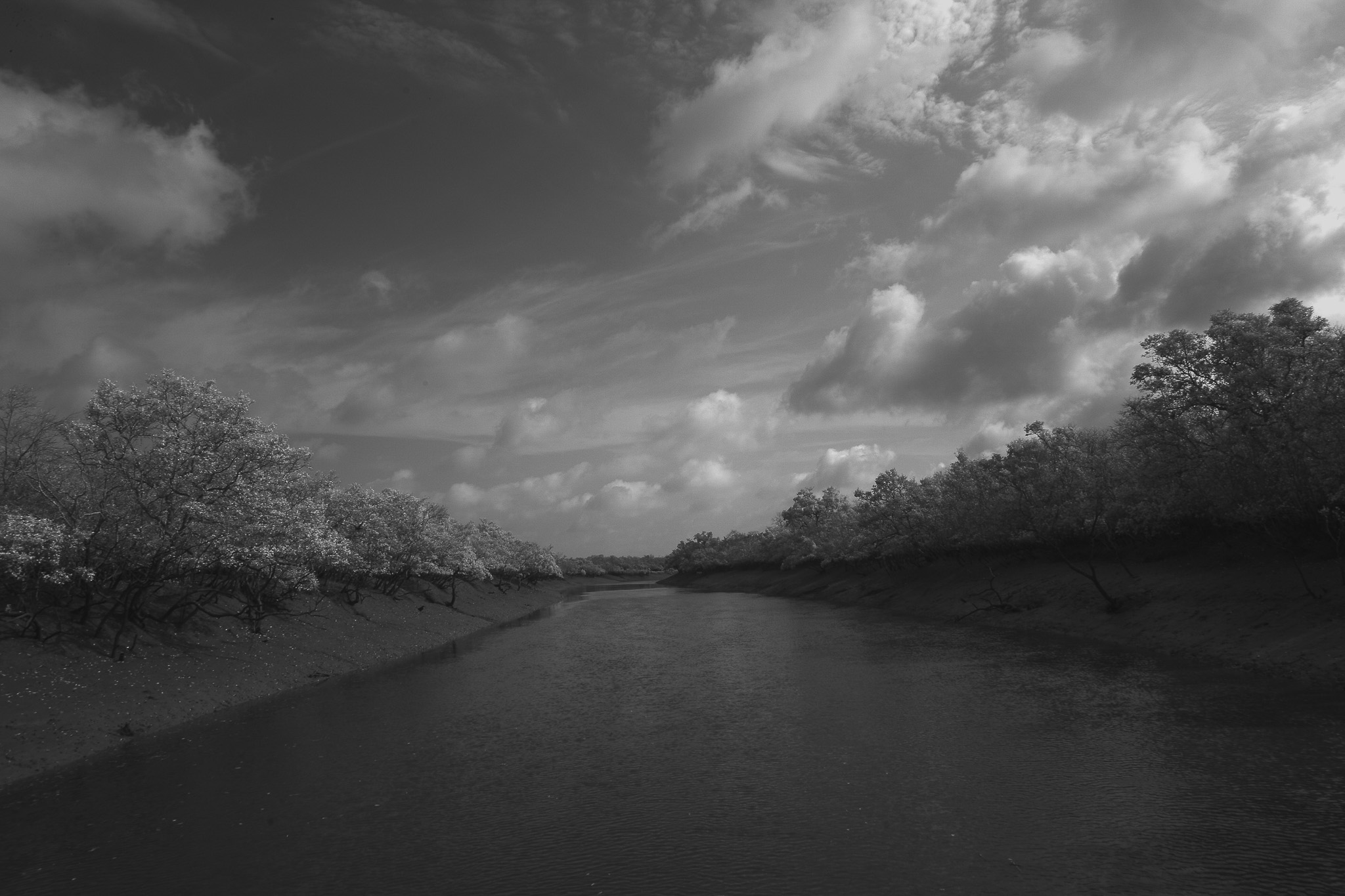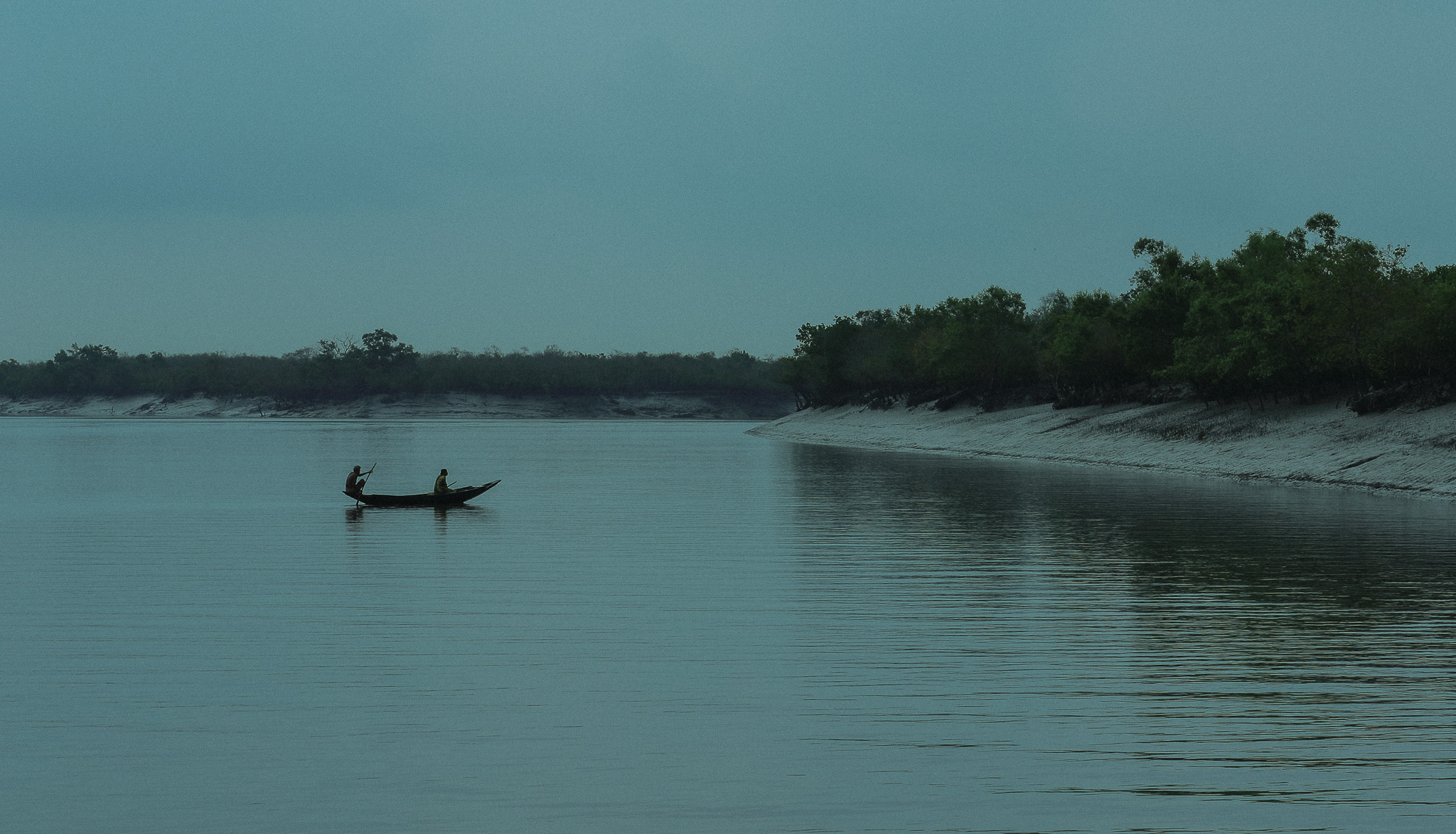A late-night wakeup call.
Soon after dinner, we had just about turned off the lights and were getting ready to doze off, when the sudden burst of firecrackers made us jump out of our beds. A bit strange, as this was no place for pranks. There was a stir outside with alarmed voices. Rushing outside, I was told that the forest guards were trying to scare away a tiger and stop it from entering the village. I peered into the darkness, in the direction of the sighting, hoping to catch a glimpse of the tiger, fully aware that the double-layered, tall wire mesh walls erected to keep the tigers from entering the rest-house will not be breached. This is one of those nights at Sundarbans, where man needs to be inside the cage while outside the wild tiger roams his kingdom free, often hungry for prey.
Here one has to be very cautious. Here the rules are different, and it pays to heed them carefully. For this is the man-eaters’ terrain.
Sundarbans (21°31′00″ N – 22°30′00″ N, 88°10′00″ E – 89°51′00″ E) located on the southern fringe of the state of West Bengal (the eastern part of India) on the Ganges delta is unlike any other forest of India. This is a misty, river infested forest growing where land meets sea, and fresh water meets sea water. This is an environment that is constantly shifting with the tide that comes in twice a day. So, first things first, Sundarbans isn’t a place where you undertake safaris on jeeps and elephants where the driver or the mahout doesn’t hesitate to bound across dense vegetation, draw near or pause long enough for photographers and shutter-happy folks to click to their heart’s content.
The Law of the Tiger – the first law of Sundarbans
In Sundarbans, a natural biosphere, tigers don’t have fear of man and actively prey on people. This is where the laws of the jungle are a little different and that’s clearly determined by the predators here.

The name Sundarbans is said to be derived from Sundari (Heritiera fomes),a reference to the large mangrove trees that provide valuable fuel. Along the coast, the southern part of the forest spills into a mangrove swamp, which has numerous wild animals and crocodile-infested estuaries. It is home to the largest number of wild tigers in the world and rightly so the site of a tiger conservation project. It is also home to the largest estuarine crocodile farms in the world at Bhagabatpur, where private tours are conducted on motorized launches. The creeks are spawning grounds for some 90 species of fish, 48 species of crabs and a large variety of molluscs.
A life guarded by the Bonbibi
Livelihoods of local communities are sustained by fishing, crab hunting, honey gathering and whatever else mother nature permits. Life here is primary and cautious. During crab hunting and fishing expeditions in the small creeks on little boats, even with people on active watch-outs, incidents of attacks by predators continue.

If one is curious as to why people risk their lives and limbs and court danger while going about their livelihood, one gets an answer that is zen-like in clarity. “We are all humans. All of us will anyway die one day”. This truth and realisation possibly define the laws of survival and life at Sunderbans.
Locals believe that Bonbibi, the goddess of the forest, protects the woodcutters, honey-gatherers and the many fishermen who go about sustaining their livelihoods in one of the more hostile terrains. Bonbibi, also Bandevi, Bandurga and Byaghradevi is a guardian spirit of the forests venerated by both the Hindu and the Muslim residents of the Sundarbans. Her vahana (mount) is a tiger or a hen. Blessings, as you must realise are necessary, as the local saying goes, `here the tiger is always watching you.
In The Hungry Tide, his 2004 environmentalist novel, Amitav Ghosh mentioned two accounts of the Bonbibi story of Dukhey’s Redemption.

Amitav Ghosh was born in Calcutta in 1956 and raised and educated in Bangladesh, Sri Lanka, Iran, Egypt, India and the United Kingdom, where he received his PhD in social anthropology from Oxford. Acclaimed for fiction, travel writing and journalism, his books include The Circle of Reason, The Shadow Lines, In an Antique Land and Dancing in Cambodia.
Hush! Lest you take a wrong turn.
Early next day, at dawn, when we sight the fresh pugmarks of a tiger outside the wire-mesh walls of the rest-house, for the first time I sensed a hint of fear in the eyes of the tourists. It is but natural, and for first-timers to Sundarbans, it’s where you wake up and smell the jungle. In Akira Kurosawa’s classic ‘Seven Samurai’, Kambei who is the leader of the Samurai tells Kikuchiyo “one who has never been hunted, would not understand”. People who haven’t come face-to-face with death, often don’t have a deep enough perspective of life. People don’t realise how ephemeral life is.
If you have missed the Seven Samurai by Akira Kurosawa, here it is:

For the urban class, caught up in its mad race to accumulate material wealth, waging immaterial battles within the workplace, often some bending rules to claim from nature, its precious habitats and devastating ecosystems, this may be the most effective morning alarm, shaking them up to the core and make them rethink priorities. Even though the tiger will not climb up to our large motor launch, nor the crocs are expected to do a black water on you, the thought of death has a calming effect on all.
A biosphere reveals itself
Man, since time immemorial has worshipped the elements of nature like the Sun, water, sky, earth, wind etc. As we scurry towards the motorboat, we witness the Sun rising from the waters, cracking open dawn to present a sight truly to behold. The beauty of the rising Sun makes many rush for their smartphones and cameras. The air is still as if paying homage to the gleaming sun, punctuated by just the clicks of the shutters. That done, everyone soon settles into being transfixed, marvelling as the forest around and the waters reveal themselves and a quiet prayer escapes the lips of many.

Evergreen mangrove forests here support myriad forms of life, which hide during the hide tide and reveal themselves on the shimmering mud flats during the ebbing tide. The land is split by numerous rivers and water channels all emptying into the Bay of Bengal. Sundarbans lords over 10,000 square kilometres spread across India and Bangladesh.
Instagrammers on cloud 9
The skies here are littered with clouds. Over the years, having clicked many images of clouds, when I look back at the photographs, I am reminded about the range of emotions it induces from feeling overwhelmed, to wonder and often sheer joy. Sundarbans brings out the inner child. When we were kids, we used to get intrigued by the shapes of the passing clouds. And I guess for some it continues till adulthood, as it did for Kalidasa’s Meghaduta, where the banished Yaksha wanting to convey his message to his beloved, prays to the clouds:
“Hail, friend of Indra, counsellor divine,
illustrious offspring of a glorious line!
Wearer of shapes at will; thy worth I know,
And bold entrust thee with my fated woe…”

And then a sudden turn of weather.
Sundarbans is a primordial landscape and doesn’t take the ego of man so easily. We faced a massive hailstorm and the water turned pitch dark. This is a land at the mercy of nature, blessed by her as it is.

Often as your views meander across or you are sitting down to feast on some juicy large lobsters and local cuisine, you get called out either for a sighting of a large saltwater crocodile basking in the sun, dolphins swimming by your side, a water monitor swimming alongside or best, fresh pugmarks of a tiger. Nowhere else, do you get the pleasure of enjoying your favourite meal while watching a fine natural history moment unfolding before you. Sundarbans can turn you meditative one moment and jolt you into action the very next.
It’s a survival jungle, stay guided.
One couldn’t help but marvel at the sleek and powerful build of a Peregrine falcon, which are known to swoop down from the sky at 320kmph and hunt birds with its powerful talons and beak, almost laser-guided by its large, beautiful eyes. Its delicately, almost painted feathers remind you of the carefree 60s.

As the morning lifted and the fog had slithered away, I got my glimpse of the lithe Jungle Cat also known as the Swamp Cat. They are often found sitting amidst the tiger palm trees (Hental Bon, in the local language) either sunning themselves or looking out for small prey. It is a powerful small feline which has to swim a lot and wade through rivers.

And then we saw the lord of the waters, a giant estuarine crocodile, which in no small way conveys it is not to be messed with.

The sighting of the King of the jungle, the Royal Bengal Tiger, however eluded me on this trip. But then that’s Sunderbans, unpredictable with what it might throw at you. You are likely to see wild boars, spotted deer, monkeys, a huge variety of birdlife, reptiles and the Olive Ridley Turtle.

Sajnekhali has a bird sanctuary with observatory watch towers and a Mangrove Interpretation Centre. You get the veritable bird kingdom with the Asian openbill stork, black-necked stork, greater adjutant stork, white ibis, swamp francolin, white-collared kingfisher, black-capped kingfisher and the brown-winged kingfisher. Sundarbans is a biodiversity treasure trove. It has at least 1586 species of Protozoa and Animalia apart from 69 floral species belonging to 29 families.
In a hostile slushy landscape like Sunderbans, it always makes sense to have a local guide given that the contours of the land change with every tide. And the jungle hides many a predator.
Wild Honey kingdom
The local honey that one gets to buy is quality nectar that any home kitchen would love to possess. It is worth its weight in gold as it is a critical mode of livelihood for the locals who live this sustainable yet fragile life at the mercy of nature. There are 60 species of mangrove and mangrove associated with Sundarbans with each species flowering at a different time of the year. So, during different months, the taste of honey varies as the honeybees collect nectar from different species of mangroves. What you buy goes a long way in helping the gatherers.

Mangrove marvel
Mangroves are 4 times more efficient in carbon sequestration (long-term storage of carbon dioxide or other forms of carbon to either mitigate or defer global warming and avoid dangerous climate change) than other tree species. Sundarbans Tiger Reserve has a carbon stock of 22.38 million tonnes. As we reached the Sundarbans, we could immediately feel the difference in the air that we breathed in. Mangroves also play a major role in preventing soil erosion and stopping storm surges. It is estimated that the service provided by Sundarbans Tiger Reserve (STR) in moderating cyclones is worth Rs.27.5 crore per annum. Using the social cost of Carbon for India the total economic value of Carbon sequestered in STR is estimated at Rs.46.21 crore per annum. Mangroves are also rich breeding grounds for fish and the economic value of fish caught in Sundarbans Tiger reserve is estimated at Rs. 160 crores per annum. In an era of climate change, these are significant figures and remind us why Sundarbans need to be protected.
Good green ethics is great economics.
As they say, you won’t protect something which you won’t love. And you won’t love something, which you haven’t experienced. Sundarbans is that tucked-away paradise that changes you without you even knowing it.

In and around
Other interesting places in the area include Netidhopan, which has the ruins of a 400-year-old temple, Holiday Island, which is a retreat of the barking deer and Kanak, which is the nesting place of Olive Ridley Turtles. Piyali is 72 km from Calcutta and is a gateway to the Sunderbans. It is being developed as a tourist complex.











